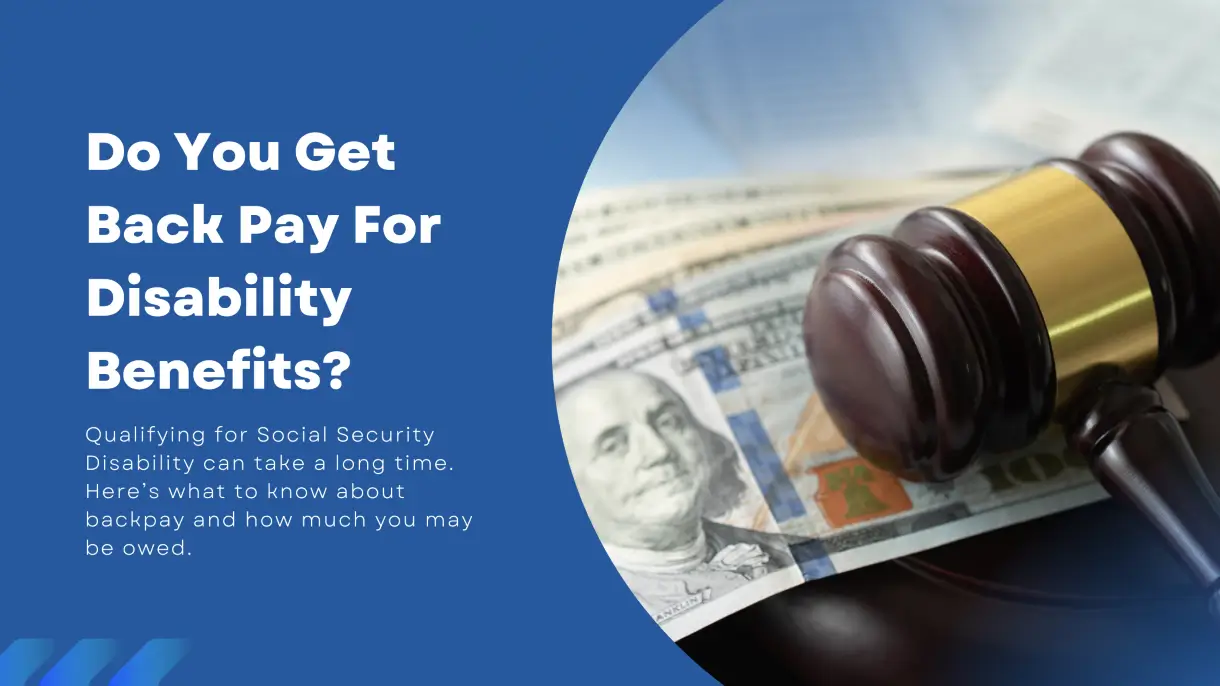Are you entitled to back pay for disability benefits such as SSI and SSDI? Understanding the concept of back pay and its application to disability benefits can be crucial for those navigating the process. Back pay refers to payments owed to individuals for the period between when they applied for benefits and when they were approved for them.
For SSI and SSDI recipients, back pay can provide much-needed financial support. Discover if you qualify for disability back pay and how it can make a difference in your financial situation.
Ready to see if you may qualify? Click here to get a FREE, no-obligation consultation before starting your claim.
What is Disability Back Pay?
Disability back pay refers to payments made to individuals who have been approved for disability benefits but experienced a delay in receiving those benefits. When someone applies for Social Security Disability Insurance (SSDI) or Supplemental Security Income (SSI) benefits, there is often a waiting period during which their application is reviewed and approved. Once approved, benefits typically start from the date of the application, but it can take several months or even years for the application to be processed.
During this waiting period, individuals may continue to accumulate entitlement to benefits. Disability back pay is the lump sum payment that covers the period from when the individual became eligible for benefits (the onset date of their disability) to the date when their benefits actually begin. This lump sum payment is meant to compensate for the delay in processing the application.
How Is My Lump Sum Payment Calculated?

There are two important dates to understand when it comes to calculating how much back pay you’ll get. The first is your “alleged onset date,” or AOD. It indicates the date when your disability began — or, more specifically, the date you could no longer work due to your disability. If you don’t write down a specific disability onset date on your application forms, the SSA sets your AOD as the date when you first applied for benefits.
Here’s where things get a bit tricky.
After your claim’s approved, the SSA will change your AOD to an “established onset date,” or EOD, to use in its place. Back pay covers any amount the SSA would have paid if they immediately approved your claim on the date you filed. Since the SSA has a mandatory five-month waiting period, they’ll automatically owe you those months’ backpay on approval — and possibly more.
Types of Disability Back Payments
There are two main types of disability back payments: one associated with Supplemental Security Income (SSI) and the other with Social Security Disability Insurance (SSDI).
SSDI Back Pay Benefits: What to Expect
There are two types of disability benefits available to those with approved claims. The first, SSDI, is short for Social Security Disability Insurance. Your FICA tax contributions withheld from every paycheck pays for SSDI benefits. In other words, it’s your money — you’ve been paying for this insurance for years! If you’ve worked full-time for 5 in the 10 most recent years before your claim’s approved, you can collect up to 12 months of back payments in addition to monthly SSDI.
If you haven’t worked consistently or recently enough in the past, you may still qualify for some federal disability benefits. However, a program called Supplemental Security Income (SSI) pays for these benefits, which aren’t funded out of beneficiaries’ past paychecks. Instead, SSI payments come from the U.S. Treasury.
SSI Back Pay Benefits: What to Expect
Disability back pay is handled differently between SSDI and SSI. Whereas SSDI entitles you to up to 12 months of back pay starting from either your application date or the start of your disability, plus 5 months for the waiting period, recipients of SSI are only entitled to benefits beginning the month after you apply for benefits. The backpay you receive for SSI benefits will only cover the period starting from when you applied to when you were approved.
Is There a Maximum Amount for Disability Back Payments?
The maximum amount for disability back payments is typically capped at 12 months, in addition to the 5-month waiting period. This means that individuals approved for disability benefits may receive retroactive payments dating back up to a year from the date of their application, provided they meet the eligibility criteria. These back payments serve to compensate for the time it takes for the Social Security Administration (SSA) to process disability claims, ensuring that beneficiaries receive the financial support they are entitled to in a timely manner.
How Are Disability Back Payments Disbursed?

SSDI disability back pay is disbursed in one lump sum payment, though the actual timeframe for when you receive the money may vary. Your SSDI payment should be paid out in a check or direct deposit one to two months after you’re approved for benefits.
For SSI disability back pay, you may either receive a lump sum or a payment installment depending on the size of the payment. While some payments are distributed as lump sums, your payment may be distributed in installments if:
- Your payment amount equals or exceeds three times the current 2024 maximum Federal Benefit Rate (FBR) of $943.
- The payment amount meets or exceeds the current federally administered State supplement.
Is Back Pay the Same as Retroactive Benefits?
No, disability backpay is different from retroactive benefits for disability. Disability back pay is distributed in one lump sum payment to individuals on SSDI and SSI to reimburse them for the time between when they applied and when they were approved. Retroactive benefits are benefits paid out for the time since you became disabled to when you applied for disability benefits.
Do I Qualify for Retroactive Payment?
Many people stay sick or disabled for years before filing a disability benefits application. If that describes you, then you may qualify for retroactive pay. This type of back pay covers the 12 months before your EOD. If you qualify for it, you’ll get retroactive pay in addition to the five months in back payments you’re owed.
To receive retroactive payments, you’ll need to present medical records that show an earlier onset date for your condition than the one the DDS medical examiners choose. Only people with approved disability claims are eligible for retroactive pay. Finally, there must be no official reason to withhold your retroactive or back payments. (Some reasons for withholding lump-sum SSD payments include things like unpaid income taxes or child support.)
How to Track My Disability Back Pay
If you want to track the status of your disability payments, the Social Security Administration has a toll-free number you can call to receive information about your back payments. Call 1-800-772-1213 to uncover your claim status and to find out if your back payment has been processed and deposited into your bank account.
Work With a Disability Attorney
If you feel the SSA set the wrong EOD and you deserve more retroactive pay, you can always appeal. You’ll need lab or test results to support your request as well as your doctor’s completed RFC forms. “RFC” stands for “Residual Functional Capacity,” and it covers how well you mentally or physically function. You’ll also want to provide any previous disability claims you filed with the SSA in the past.
Finally, if this process seems totally overwhelming to you, talk to a local Social Security lawyer. No lawyer will charge you for a one-time consultation about your disability claim. Not sure where to find one that’s qualified in your area? We can match you with one in your ZIP code today, free of charge!
Ready to see if you may qualify? Click here to get a FREE, no-obligation consultation before starting your claim.
Laura Schaefer
Laura Schaefer is the author ofThe Teashop Girls,The Secret Ingredient, andLittler Women: A Modern Retelling. She is also an active co-author or ghostwriter of several nonfiction books on personal and business development. Laura currently lives in Windermere, Florida with her husband and daughter and works with clients all over the world. Visit her online at lauraschaeferwriter.com and linkedin.com.

